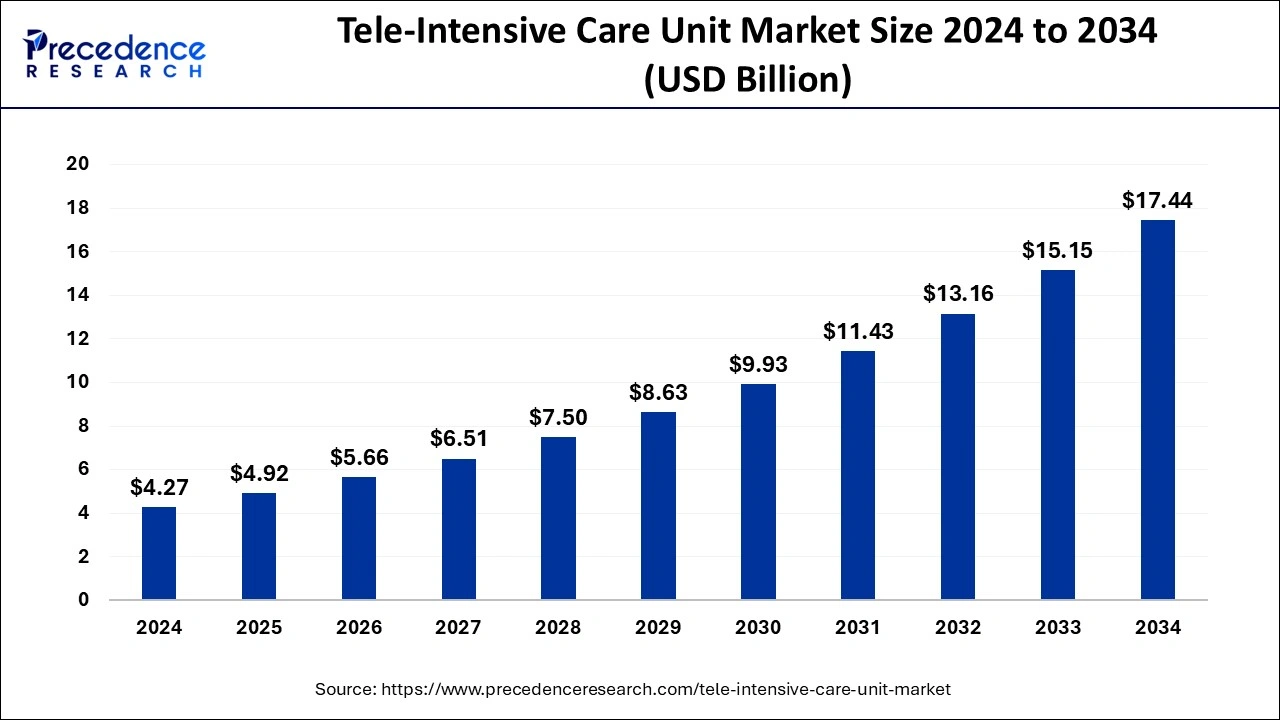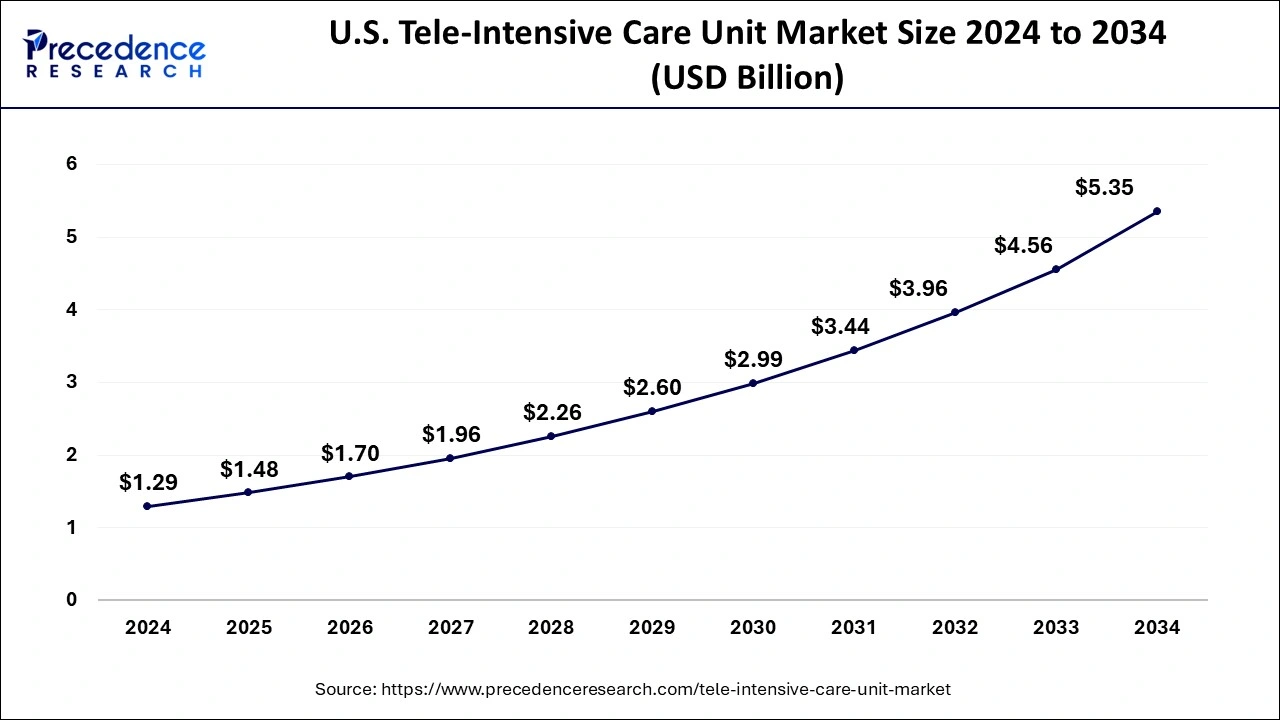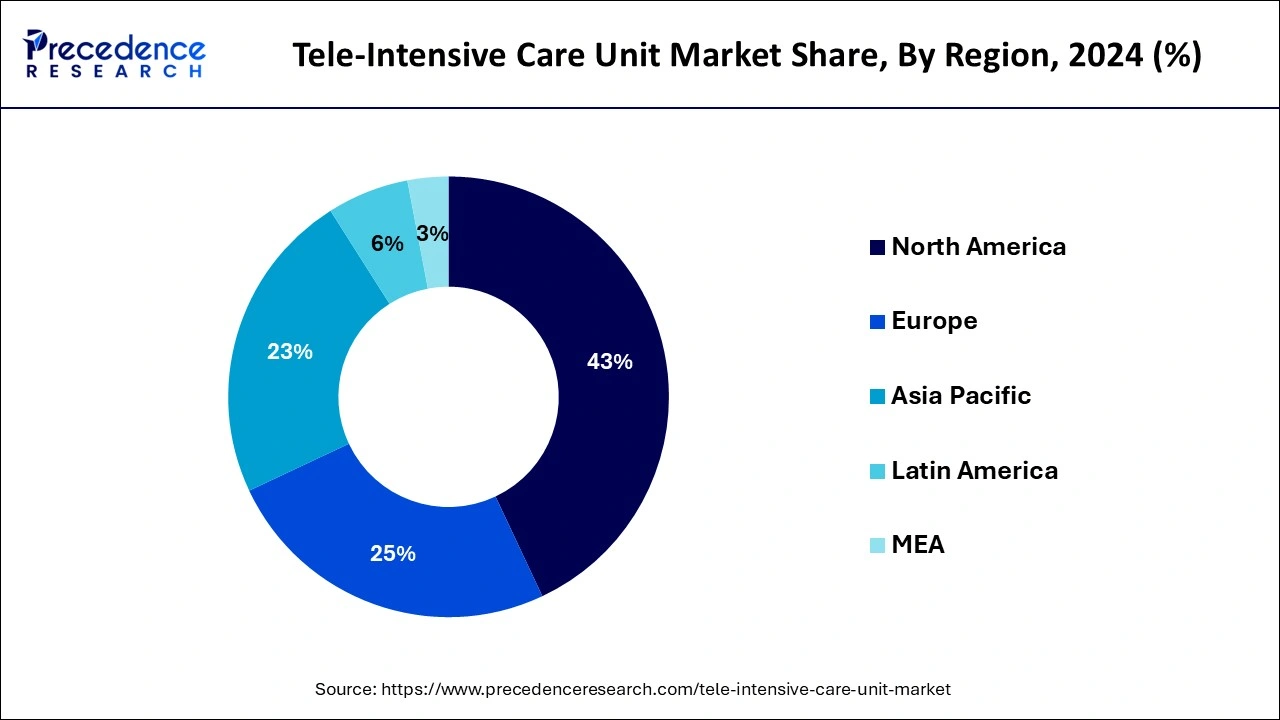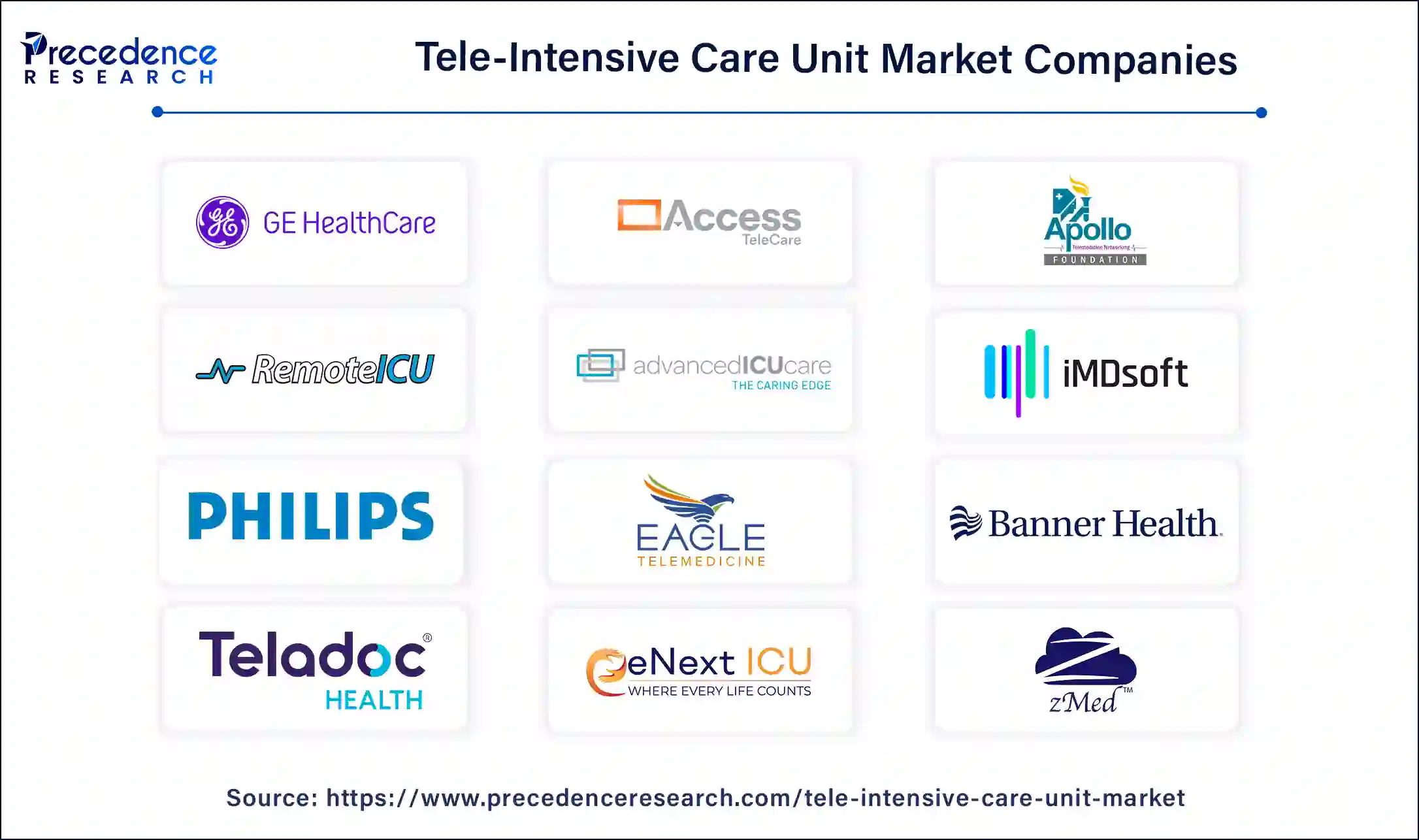January 2025
The global tele-intensive care unit market size was calculated at USD 4.27 billion in 2024, grew to USD 4.92 billion in 2025 and is predicted to reach around USD 17.44 billion by 2034, expanding at a solid CAGR of 15.11% between 2025 and 2034. The North America tele-intensive care unit market size is evaluated at USD 1.84 billion in 2024 and is expected to grow at a CAGR of 15.22% during the forecast year.
The global tele-intensive care unit market size was accounted for USD 4.27 billion in 2024 and is expected to exceed around USD 17.44 billion by 2034, growing at a notable CAGR of 15.11% from 2025 to 2034. The rising number of challenges in the ICU healthcare system can be resolved with the help of audiovisual technology and electronic medical records, contributing to the expansion of the tele-intensive care unit market.

The constantly adapting and evolving platform of healthcare and the integration of artificial intelligence in telemedicine and tele-intensive care units are transforming the approach towards critical care. The involvement of health-tech companies equipped with full-stack AI and operations companies are collaborating with hospitals to handle patients in their intensive care units and emergency departments. Physicians are demanding a holistic solution combining clinical expertise and technology design according to the respective hospital environment to deal with the access to quality control, which simply cannot be dealt with through digital platforms or hiring ICU consultants. The AI and the tele-intensive care unit market together are creating a more responsive, efficient, and effective critical care environment.
The U.S. tele-intensive care unit market size was exhibited at USD 1.29 billion in 2024 and is projected to be worth around USD 5.35 billion by 2034, growing at a CAGR of 15.29% from 2025 to 2034.

North America dominated the global tele-intensive care unit market in 2024. The dominance of this region is observed due to the advanced IT infrastructure and high-speed internet connectivity providing a robust communication network. The presence of key IT service players such as IBM, Accenture PLC, Microsoft Corp., Infosys Ltd, Wipro Ltd, and many more are propelling the market growth. The establishment of modern infrastructure in North America includes next-generation technology and services utilized for the development of IT environments that are flexible, scalable, and agile. Moreover, North America is creating groundbreaking standards in 5G adoption reaching 264 million connections by the end of 2024.

Asia Pacific is anticipated to witness the fastest growth in the tele-intensive care unit market during the forecasted period. The expansion of the region is experienced due to the increasing adoption of telehealth solutions. The dominant countries in Asia Pacific are China, Indonesia, and the Philippines. Telehealth comprises telemedicine, which uses telecommunication technologies such as smartphone applications to create medical information and services that are accessible to patients on a digital platform.
An intensive care unit is an off-site clinician who interacts with the bedside staff to consult on patient care. This collaborative venture through tele-ICU is known to elevate care and outcomes. The tele-ICU program empowered busy hospitals during the COVID-19 pandemic by providing care for patients while minimizing infection risk and utilizing personal protective equipment. Even after the pandemic, tele-ICU is an impressive way to augment limited resources in rural areas that lack critical care expertise and urban areas are facing temporary rises in traffic. An ideal operations center has the capacity to support nearly 250 intensive care unit beds across various organizations. Bedside and operations center clinician collaboration with intensivists creates an advanced ecosystem of technology.
| Report Coverage | Details |
| Market Size by 2024 | USD 4.27 Billion |
| Market Size in 2025 | USD 4.92 Billion |
| Market Size in 2034 | USD 17.44 Billion |
| Market Growth Rate from 2025 to 2034 | CAGR of 15.11% |
| Dominating Region | North America |
| Fastest Growing Region | Asia Pacific |
| Base Year | 2024 |
| Forecast Period | 2025 to 2034 |
| Segments Covered | Component, Type, and Regions |
| Regions Covered | North America, Europe, Asia-Pacific, Latin America, and Middle East & Africa |
Critical care and aging population
Leveraging technology directly impacts the growth of remote critical care services and care for the aging population. There has been a significant reduction in mortality rates and an improvement in patient safety results. This is achieved with the provision of the centralized monitoring model (CCM) – a coordinated team of nurses, doctors, and support staff who receive constant information of fully integrated patient data. Another is the visual consultant model (VCM) – an on-demand system that offers episodic support through audiovisual devices and teleconsulting. Additionally, for an aging population, doctors and consultants can monitor the early detection and prevention of heart problems through the tele-intensive care unit market.
Technical issues
Implementation of tele-intensive care unit market services in a hospital setting leads to several challenges that need to be resolved with careful planning and the right strategies. However, the primary challenge faced when it comes to tele-ICU is the technical difficulties. These operational hurdles include network connectivity and compatibility issues during the tele-intensive care unit communication. This issue can be eliminated by ensuring robust infrastructure, such as a secure internet connection and reliable hardware which is provide seamless data transmission. Additionally, regular maintenance and updates will ensure the proper working of the system without any disruption.
Advancement and development
The remarkable development in the tele-intensive care unit market is witnessed due to the advancement in remote monitoring technologies. Recently the Tele-ICU solution demonstrated its capabilities through remote adjusting ventilator settings, a development acknowledgment – FDA approved. The future of tele-ICU is expected to incorporate artificial intelligence to detect subtle changes in patient conditions. This fast effectiveness results in offering timely and pre-emptive care. New advancements open ways for small facilities to provide high-level care instead of traditional specialists, leading to improvement in patient outcomes and optimizing resource utilization.
The hardware segment noted the largest share of the tele-intensive care unit market in 2024. The dominance of this segment is observed as this allows remote intensivists to monitor patient's health and provide care. The basic hardware equipment comprised in the tele-intensive care unit includes high-resolution cameras, sensors, monitors, video conferences, and communication for advanced monitoring of patient’s vital signs, including heart rate, blood pressure, and many more. Moreover, a high-speed internet connection ensures a server's uninterrupted data transmission and storage.
The software segment is anticipated to grow at the fastest CAGR in the tele-intensive care unit market during the forecast period. The expansion of this segment is noticed as it plays a crucial role in using real-time monitoring and communication. The software platforms are integrated with electronic health record (HER) systems which provide access to patients’ data and allow efficient documentation. They are also equipped with alarm systems in case of critical changes in patient conditions to alert healthcare professionals for timely intervention.
The open with consultant segment contributed the largest share of the tele-intensive care unit market in 2024. The dominance of this segment is observed as this is used as a management model for tele-ICU that allows bedside staff to connect with the specialist remotely for patient care. The tele-ICU consultant ensures adequate treatment for critically ill patients, even at hospitals in rural areas. They are connecting a bridge between the limited number of intensivists and the need for their expertise in many hospitals.
The intensivist segment is anticipated to grow with the highest CAGR in the tele-intensive care unit market from 2024 to 2034. The segment is expected to expand in the coming future due to the rising demand for intensivists. As an ICU with intensivists, constant attendance is proven to result in better outcomes. Unfortunately, fewer than 15% of U.S. hospitals have dedicated physicians in the ICUs. There are more than 5 million patients admitted to the ICU around that country each year. However, the hospital fails to provide adequate and consistent critical care for those in need.

By Component
By Type
By Geography
For inquiries regarding discounts, bulk purchases, or customization requests, please contact us at sales@precedenceresearch.com
No cookie-cutter, only authentic analysis – take the 1st step to become a Precedence Research client
January 2025
January 2024
September 2024
January 2025